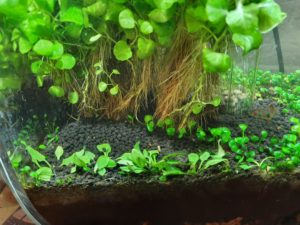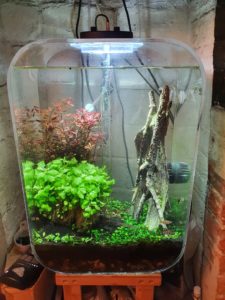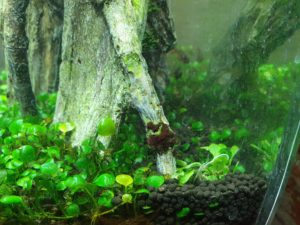Today I got in two pots of Cryptocoryne lutea ‘Hobbit’ from Aqua Essentials as grown by Dennerle. The idea is to fill in some of the space in front of the lobelia and to hide the bare stems and adventitious roots that make up the lobelia understory. As usual (always?) the plants arrived in prime condition and seemed to survive shipping in the cold British weather including storm ‘Christoph’ which was happening at the time.
I took the plants out of their pots and removed the rock wool they had been grown in. Each pot could be separated into a number of plantlets and a few extra mini-plantlets as well. The root systems were robust and healthy-looking, and the leaves also looked good, a firm dark green, although of course this represents the emersed growth form from the nursery and not the final submerged growth form for which they are now destined.
I planted four of the larger pieces in front of the lobelia on the left with the fifth and largest of the pieces by itself in the right corner by the mountain. One of the lobelia came loose while I was planting the cryptocoryne but it was easy enough to replant and I added a little aquasoil to it as well. I’m not sure the roots of these aquatic plants do much other than keep the plant vaguely in one place. The smaller hobbit plantlets I put just around to the left side and a little more towards the centre line of the tank. If it all takes and grows out it should fill in at the front nicely.
The cryptocoryne variety lutea ‘Hobbit’ is the smallest cryptocoryne form I’ve been able to find, with a catalogue stated maximum height of 5 cm, which would be about right for this location. Full light to part shade is called for and even though it would seem dark under the lobelia it is brighter by the front wall of the tank, maybe from light reflecting down through the tank walls, and a little bit of the marsilea has been able to grow there. I also pushed back the lobelia and that seemed to clear out a lot of space – absent anything to hold it back the taller lobelia tends to flop over and fill the available surroundings.
There is a phenomenon called ‘crypt melt’ which is where when cryptocoryne is moved to a different location or when the environmental conditions change, the whole upper leafy part of the plant dies and turns to mush. Eventually there will be new growth that comes up from the roots that is suitable for the new environment. For the hobbit this whole shipping/planting/immersion process has been a pretty big change of environment so I wouldn’t be at all surprised if crypt melt happened here. It’s not a problem, just something to watch out for to remove the dying parts before they get all decayed and muck up the water.





3 thoughts on “Hobbit in the house”